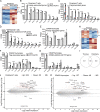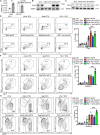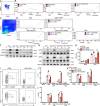Cbl-b deficiency prevents functional but not phenotypic T cell anergy
- PMID: 33974042
- PMCID: PMC8117209
- DOI: 10.1084/jem.20202477
Cbl-b deficiency prevents functional but not phenotypic T cell anergy
Abstract
T cell anergy is an important peripheral tolerance mechanism. We studied how T cell anergy is established using an anergy model in which the Zap70 hypermorphic mutant W131A is coexpressed with the OTII TCR transgene (W131AOTII). Anergy was established in the periphery, not in the thymus. Contrary to enriched tolerance gene signatures and impaired TCR signaling in mature peripheral CD4 T cells, CD4SP thymocytes exhibited normal TCR signaling in W131AOTII mice. Importantly, the maintenance of T cell anergy in W131AOTII mice required antigen presentation via MHC-II. We investigated the functional importance of the inhibitory receptor PD-1 and the E3 ubiquitin ligases Cbl-b and Grail in this model. Deletion of each did not affect expression of phenotypic markers of anergic T cells or T reg numbers. However, deletion of Cbl-b, but not Grail or PD-1, in W131AOTII mice restored T cell responsiveness and signaling. Thus, Cbl-b plays an essential role in the establishment and/or maintenance of unresponsiveness in T cell anergy.
© 2021 Nguyen et al.
Conflict of interest statement
Disclosures: A. Weiss reported personal fees from Nurix Therapeutics and personal fees from Genentech outside the submitted work and is a co-founder of Nurix Therapeutics, a publicly traded company in which he owns stock and has received consulting fees since it was founded in 2012. Nurix is developing small molecule inhibitors of Cbl-b for use in immuno-oncology. Current inhibitors are in preclinical development. The studies performed here examine the role of Cbl-b in T cell anergy using knock out mice and find that Cbl-b is an important negative regulator of functional anergy. Neither A. Weiss, nor his lab, have had access to any small molecule inhibitors developed at Nurix. The studies reported here do not directly relate to immuno-oncology. A. Weiss is also on the Scientific Resource Board of Genentech, for which he receives financial compensation. Genentech has developed anti-PDL-1 monoclonal antibodies for use in immuno-oncology. The role of PD-1 in a mouse model of T cell anergy was studied here. Deficiency of PD-1 had no apparent effect on the model of T cell anergy studied here. No other disclosures were reported.
Figures













Similar articles
-
Casitas B lineage lymphoma b is a key regulator of peripheral tolerance in systemic lupus erythematosus.Arthritis Rheum. 2013 Apr;65(4):1032-42. doi: 10.1002/art.37833. Arthritis Rheum. 2013. PMID: 23280105
-
Anergic CD4+ T cells form mature immunological synapses with enhanced accumulation of c-Cbl and Cbl-b.J Immunol. 2010 Apr 1;184(7):3598-608. doi: 10.4049/jimmunol.0902285. Epub 2010 Mar 5. J Immunol. 2010. PMID: 20207996 Free PMC article.
-
Activation of T cells: releasing the brakes by proteolytic elimination of Cbl-b.Sci Signal. 2009 Jun 23;2(76):pe38. doi: 10.1126/scisignal.276pe38. Sci Signal. 2009. PMID: 19549983 Review.
-
Visualizing the role of Cbl-b in control of islet-reactive CD4 T cells and susceptibility to type 1 diabetes.J Immunol. 2011 Feb 15;186(4):2024-32. doi: 10.4049/jimmunol.1002296. Epub 2011 Jan 19. J Immunol. 2011. PMID: 21248249
-
Regulation of peripheral T cell tolerance by the E3 ubiquitin ligase Cbl-b.Semin Immunol. 2007 Jun;19(3):206-14. doi: 10.1016/j.smim.2007.02.004. Epub 2007 Mar 27. Semin Immunol. 2007. PMID: 17391982 Review.
Cited by
-
Ocular immune privilege in action: The living eye imposes unique regulatory and anergic gene signatures on uveitogenic T cells.Cell Rep. 2025 Jun 24;44(6):115780. doi: 10.1016/j.celrep.2025.115780. Epub 2025 May 30. Cell Rep. 2025. PMID: 40450686 Free PMC article.
-
The ubiquitin-proteasome system in the tumor immune microenvironment: a key force in combination therapy.Front Immunol. 2024 Sep 9;15:1436174. doi: 10.3389/fimmu.2024.1436174. eCollection 2024. Front Immunol. 2024. PMID: 39315102 Free PMC article. Review.
-
Mechanisms of Cbl-Mediated Ubiquitination of Proteins in T and Natural Killer Cells and Effects on Immune Cell Functions.Life (Basel). 2024 Dec 3;14(12):1592. doi: 10.3390/life14121592. Life (Basel). 2024. PMID: 39768300 Free PMC article. Review.
-
Stimulation of ectopically expressed muscarinic receptors induces IFN-γ but suppresses IL-2 production by inhibiting activation of pAKT pathways in primary T cells.Proc Natl Acad Sci U S A. 2023 Jun 20;120(25):e2300987120. doi: 10.1073/pnas.2300987120. Epub 2023 Jun 12. Proc Natl Acad Sci U S A. 2023. PMID: 37307442 Free PMC article.
-
CD28 co-stimulation: novel insights and applications in cancer immunotherapy.Nat Rev Immunol. 2024 Dec;24(12):878-895. doi: 10.1038/s41577-024-01061-1. Epub 2024 Jul 25. Nat Rev Immunol. 2024. PMID: 39054343 Review.
References
-
- Anandasabapathy, N., Ford G.S., Bloom D., Holness C., Paragas V., Seroogy C., Skrenta H., Hollenhorst M., Fathman C.G., and Soares L.. 2003. GRAIL: an E3 ubiquitin ligase that inhibits cytokine gene transcription is expressed in anergic CD4+ T cells. Immunity. 18:535–547. 10.1016/S1074-7613(03)00084-0 - DOI - PubMed
-
- Bachmaier, K., Krawczyk C., Kozieradzki I., Kong Y.Y., Sasaki T., Oliveira-dos-Santos A., Mariathasan S., Bouchard D., Wakeham A., Itie A., et al. . 2000. Negative regulation of lymphocyte activation and autoimmunity by the molecular adaptor Cbl-b. Nature. 403:211–216. 10.1038/35003228 - DOI - PubMed
-
- Benjamini, Y., and Hochberg Y.. 1995. Controlling the False Discovery Rate - a Practical and Powerful Approach to Multiple Testing. J. R. Stat. Soc. B. 57:289–300. 10.1111/j.2517-6161.1995.tb02031.x - DOI
Publication types
MeSH terms
Substances
Grants and funding
LinkOut - more resources
Full Text Sources
Other Literature Sources
Molecular Biology Databases
Research Materials
Miscellaneous

